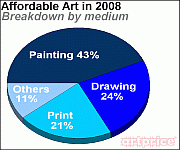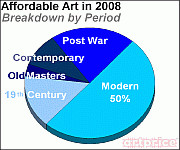Affordable art: a diversified market
[18 May 2009] For 10 years now a special “roaming” art fair has been dedicated to affordable art contributing to dispelling the notion that art is elitist and beyond the budgets of the masses. From 4 to 7 June 2009, the Affordable Art Fair is returning to Paris, at the Espace Champerret, having already visited London, Sydney, Amsterdam, New York and Brussels. Young collectors and informed non-professionals seeking new talents can discover more than 600 artists at prices ranging from 100 to 5,000 euros.  Whereas the most expensive art works on the market are normally auctioned in London and New York, Europe is the champion of affordable art at auction. In a ranking of works sold for less than €5,000 in 2008, Germany was in first place with 86%, France second with 83% and Italy third with 76.4%.
Whereas the most expensive art works on the market are normally auctioned in London and New York, Europe is the champion of affordable art at auction. In a ranking of works sold for less than €5,000 in 2008, Germany was in first place with 86%, France second with 83% and Italy third with 76.4%.
According to a common belief, affordable art is a market reserved for reproductions – prints, photographs or sculptures – where the multiplication of the number of copies automatically reduces their value. However, this notion is very substantially belied by the figures since 67.5% of works sold at under €5,000 in the world are unique pieces on canvas or paper. The “under €5,000” segment is a highly diversified market covering all materials and all periods. The most heavily represented period in this price bracket is Modern Art with 50% of all works sold worldwide. The artists most frequently sold at under €5,000 are also the most productive: Pablo PICASSO is in first place. In 2008, more than a thousand Picasso’s were accessible below this threshold, representing 58% of his works sold at auction in the year. This high ratio, even if it may seem paradoxical for the most expensive artist on the market, was due to the huge number of Picasso prints on the market representing 63% of his total transactions. Of course, the post-Picasso generation produced the truculent Salvador DALI whose 60 years of creativity and whose pronounced interest in multiples made his works accessible to the widest possible public (80% of his 2008 hammer prices were under €5,000). A generation later, Andy WARHOL took over where Dali left off, borrowing screen-printing techniques from advertising. His screen-prints of Marylin and his Flowers generously supply the inventory of affordable works with major signatures. Since then, plenty of other artists, particularly in Asia, have used new production methods inspired by Andy Warhol including the current leader (in terms of price) of the Japanese art market, Takashi MURAKAMI. Murakami has adopted the Warholian Factory model by setting up the Kaikai Kiki Corporation through which he markets “accessories” of his art. Murakami deliberately intends to blur the line between art and mass produced consumer goods, to the point where his Manga dolls in PVC change hands for roughly a hundred euros at auctions. At the same time, 4 works by Murakami sold above the €1 million line in 2008. Other Japanese artists are also working in a similar field including Ayako ROKKAKU who generates a large number of works at under €5,000, not with multiples, but with acrylic paintings on canvas. Will the young Rokkaku follow the same path opened by her mentor Murakami? In any event, her price index acquired a new dimension in 2008 when it broke the symbolic barrier of €10,000 with a painting entitled Girl in red dress at Est-Ouest Auctions Co., Tokyo (12 July). Among contemporary artists, some have a particularly well-honed marketing and communication approach (Jeff KOONS and Damien HIRST of course, but also the Belgian artist, Wim DELVOYE). Demonstrating excellent strategic acumen, they have all launched a twin production system: one that is industrious and reserved for a wealthy elite, and another that is very affordable and floods the market with mnemonic images. The new generation of artists born in the 70s and 80s is still relatively unexposed to the auction world and their price indices are not yet rooted in the secondary market. There are one or two exceptions, but these are either artists whose media attention has fuelled rampant speculation (BANKSY) or emerging artists on the new Chinese, Indian or Japanese markets which receive very strong local support.
Among contemporary artists, some have a particularly well-honed marketing and communication approach (Jeff KOONS and Damien HIRST of course, but also the Belgian artist, Wim DELVOYE). Demonstrating excellent strategic acumen, they have all launched a twin production system: one that is industrious and reserved for a wealthy elite, and another that is very affordable and floods the market with mnemonic images. The new generation of artists born in the 70s and 80s is still relatively unexposed to the auction world and their price indices are not yet rooted in the secondary market. There are one or two exceptions, but these are either artists whose media attention has fuelled rampant speculation (BANKSY) or emerging artists on the new Chinese, Indian or Japanese markets which receive very strong local support.
The young generation of Indonesian artists appears to be the champion of the under €5,000 market. Artists like Bob Sick YUDHITA AGUNG, Ugo UNTORO, Ugo UNTORO or Erica HESTU WAHYUNI, still unknown in France, make frequent appearances at auctions in Singapore and Jakarta and are also included in catalogues by Sotheby’s in Hong-Kong… building a bridge between Asia and the West whose foundations are being consolidated sale after sale.




 0
0
